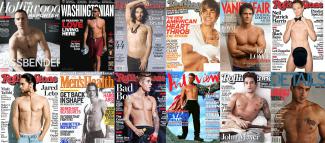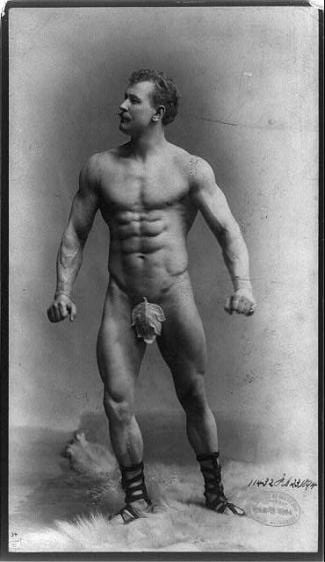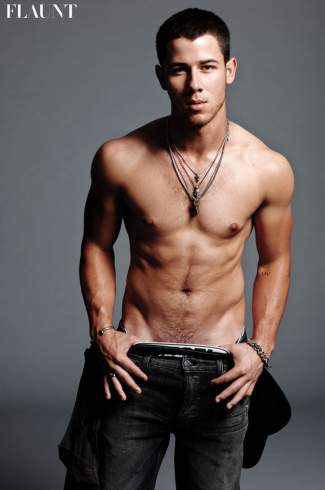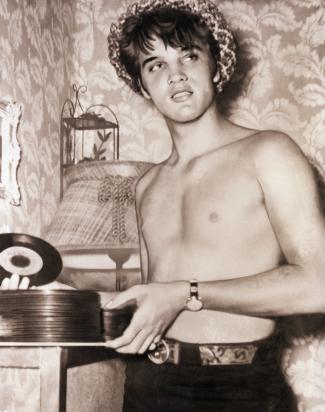What Makes A Celebrity Take Off His Shirt?
When we see a man showing his chest, what do we think? There are so many variations of response to a nipple, a pec, a stomach, shoulders, smooth or hairy, fit or firm or fat. Then again, it may depend on who the man is, where he is, what he represents.
In a lengthy examination as to why celebrities take their shirts off, BuzzFeed writer Anne Helen Petersen shares her thoughts on the bare chested phenomenon that goes back 100 years.
[In 1896] Photos of Sandow, sold in “cabinet cards” for 35 cents, spread across the country, while a short film of him played on continuous loop in kinetoscope parlors across the globe. An exquisitely designed magazine, Sandow’s System of Physical Training, went through three printings. He was the first naked chest of the age of the moving image, and like so many naked chests over the next century, he was the right chest at the right time, a nudity that came to mean so much more than the sum of a belly button, some carefully cultivated chest hair, and pair of revealed nipples.
Look at a moment of prominent male shirtlessness and you’ll see a culture trying to sort out its “ideal” chest, but you’ll also observe standards for how men should behave and feel in public and in private, on the job and in the bedroom. When a celebrity takes off his shirt, whether it’s Marlon Brando in the ’50s or Justin Bieber in the 2010s, he’s summoning ever-fluctuating currents of masculinity to the surface, to be read, appreciated, and analyzed.
The peice goes on to discuss the reasons why a celebrity would do such a thing, mentioning that depending on the era, celebrity shirtlessness has served as an act (a declaration) and a reaction (a means of changing a pre-existing conversation). In one section, one of our first celebrity crushes to bare his ched, Marky Mark is mentioned.
While Wahlberg’s rapping was passable at best, Calvin Klein saw that his body, and the incorrigible swagger that accompanied it, was Wahlberg’s real asset. Klein, like the rest of the fashion scene, had been fetishizing the male body for decades: According to Klein’s biographer, in 1974, Klein was walking through the Flamingo bar in New York, filled with the beautiful bodies of gay men, and had an epiphany: “He realized that what he was watching was the freedom of a new generation, unashamed, in-the-flesh embodiments of Calvin’s ideals: straight-looking, masculine men, with chiseled bodies, young Greek gods come to life.”
Men with this look would fill Klein’s advertisements through the ‘80s, but reached their apex in Wahlberg, whose look, Bordo writes, “embodied a highly masculine aesthetic that — although definitely exciting for gay men — would scream ‘heterosexual’ to (clueless) straights.”
In a series of ads, Wahlberg cycles through the various components of shirtless masculinity: In one, he grabs his crotch and signals his virility; in others, Kate Moss clings to him like an adornment. But in the third, and most famous, he laughs, as if he’s reveling in his own body.
This image is a counterpoint to both the bad-boy confrontation of Walberg’s other magazine covers and the melancholy of Depp and Pitt. It telegraphs what Wahlberg’s career would eventually become, but it also signals the deluge of shirtless bodies, and the posture that accompanied them, that was to come with the turn of the 21st century — one that played to both gay and straight desires, that made the chisel of the abs deeper, the run of the cum gutters more profound, the look of the face more ambiguous, and the meaning all the more diffuse and largely illegible.

From Rudolph Valentino, How You Can Keep Fit, Clark Gable, Brando, James Dean, Elvis, Jim Morrison, David Cassidy, Burt Reynolds, Gerald Ford, Luke Perry and Justin Bieber, Anne Helen Petersen discusses why these stars decided to discard their tops. What was the catalyst, was there a message, what was the reasoning?
Is it all in the belief that sex sells?
Head over to BuzzFeed.com for the entire piece. We've skipped to the end and inserted the last paragraph of the story.
The ubiquity and blandness of the contemporary shirtless celebrity is the product of social media, of declining photography budgets at major magazines, of the mainstreaming of steroids and the dominance of superhero franchises and the logic that accompanies it. But it’s also symptomatic of a larger, and much more unsettling, paucity of imagination: about what can make a man admirable and acceptable, but also what American audiences are capable of finding invigorating and enthralling. In 1894, all it took to set that imagination aflame was the notion of a man’s bicep. Today, we see the men’s chests offered for us and feel boredom — if we feel anything at all.
Do you agree with the summation as to why male celebrities take their shirts off?
Are we over thinking it?
Shouldn't we just enjoy it and stop asking why?
h/t: BuzzFeed





